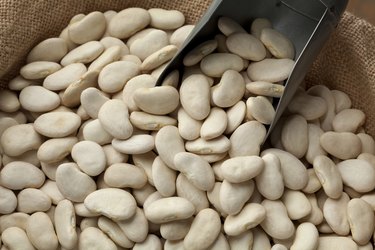
Canned butter beans may have the advantage of convenience, but dried beans produce dishes with richer, fresher flavors. Soaking the beans to rehydrate them prepares them for cooking and helps mitigate their gas-causing effects. There are two methods of soaking beans -- a slow way and a quick way. Before you soak them, look through the dried beans and remove any shriveled ones along with pebbles or debris accidentally included in the package, and then rinse the beans thoroughly.
Long-Soak Method
Video of the Day
The traditional method for soaking beans takes some advance planning, but it's the most reliable way to prepare beans that cook evenly. Put the dried butter beans in a metal pot or bowl and add cold water to about 3 inches above the level of the beans. Leave them to soak on a counter for at least 4 hours, and preferably 6 to 8 or overnight. Drain and replace the water once or twice to remove oligosaccharides, the sugars in beans that cause gas, which leach into the water. When the beans are done soaking, drain and rinse them thoroughly.
Video of the Day
Quick-Soak Method
Quick-soaking butter beans is more convenient than soaking them for hours, but it can leave some beans drier than others. Because hydrated beans cook more quickly than dry ones, you may end up with an unevenly cooked batch. Still, if you don't have time for a long soak, you can put the beans in a pot, add cold water to about 3 inches above the beans and boil them for 2 minutes. Then cover the pot and set it aside, letting the beans soak for 1 to 2 hours. As with the long-soak method, drain the beans and rinse them well when they're done soaking.
Cooking Instructions
Put the beans in a pot with fresh, cold water. Don't reuse the soaking water -- remember, it's full of oligosaccharides. Butter beans are delicate, so to help them maintain their shape while cooking, bring the water to a boil slowly, and then immediately reduce it to a light simmer. Cook the beans for up to an hour; begin checking them for doneness after 45 minutes by mashing several beans with a fork. Checking more than one bean helps you determine whether the whole pot is ready, because beans may cook unevenly.
Adding Herbs and Spices
Butter beans appear in a wide range of recipes, from Southern comfort foods to Italian side dishes to Indian curries. If you're making a dish that's heavily spiced, add the spices to the pot from the beginning. Likewise, onions, garlic and dried or woody herbs that European recipes call for can cook with the beans from the start. Add any lemon juice, vinegar, wine, tomatoes and other acidic flavorings after the beans have softened, though; otherwise, the acids can toughen the bean skins. Similarly, salt should go in the pot halfway through the cooking time or later. As with all recipes, add delicate fresh herbs during the last few minutes of cooking to preserve their subtle flavors.